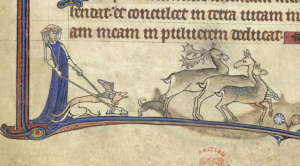Summary
Cats are tiny lions that live in your home. But how long have they lived with humans? Have they always had the position of respect they enjoy now? Also, what’s up with racoons? Em and Jesse discuss cats in the Middle Ages (and also other animals kept as pets, including squirrels, monkeys, and birds). We explore various poetic odes to cats written through the ages (real and apocryphal), examples of cats getting into trouble in scriptoria, and also a few digressions on James Joyce.
Annotations
0/ Title ref.
1/ Ghostbusters (Dr. Venkman): “Human sacrifice, dogs and cats living together–mass hysteria!” https://youtu.be/SA1SxZoFmOU
2/ Cat domestication! https://www.nationalgeographic.com/science/article/domesticated-cats-dna-genetics-pets-science
3/ CBS Sunday Morning “Are we making racoons smarter?” https://youtu.be/CnZ-8cVxhNA
Racoon GEICO commercial (there are many, here is one): https://youtu.be/gUpMoNMlCts
Interesting fact: in cities, where there is abundant food for animals like racoons and opossums, the animals start breeding year-round, rather than seasonally.
4/ Caitlin Doughty’s Will My Cat Eat My Eyeballs?: Big Questions from Tiny Mortals About Death https://www.amazon.com/Will-Cat-Eat-Eyeballs-Questions/dp/039365270X
Interview with Doughty: https://www.wbur.org/hereandnow/2019/09/10/mortician-death-caitlin-doughty-book
Webcomic Strange Planet: “Who’s a moral creature?” (i.e., dogs!) https://twitter.com/nathanwpyle/status/1233112182126235649?s=20
Strange Planet‘s vibrating creature (i.e., cat): https://twitter.com/nathanwpyle/status/1107432804822994944?s=20
Strange Planet illuminates the way we stereotypically view dogs (companions, loyal, “good” in a truly moral sense) vs the way we stereotypically view cats (aloof, solitary, untamed, amoral).
5/ Anchoresses: episode 5, especially note 3.
6/ Irina Metzler, “Heretical Cats: Animal Symbolism in Religious Discourse,” in Medium Aevum Quotidianum, vol. 59 (2009): 16–32. These stories of the cat as symbolic of the devil are from pp. 18–19.
Here is a 14th century image of the poor widow surrounded by angels and the rich man surrounded by cats (representing the evils of his life, panderers and flatterers, etc). The image is in Bibliothèque Nationale, MS fr. 312, f. 334v. The illuminator is Pierre Remiet, and the text is Vincent de Beauvais, Miroir Historial [Speculum historiale], vol. 1, 2, 4, traduction en français par Jean de Vignay. Miroir historial, vol. 1, Livres I–VIII.
See also Michael Camille, Master of Death, which is about the illuminator Remiet. This image appears in Camille on p. 157.
7/ For more on Hildegard and dogs, check out episode 29 note 27.
8/ Alain of Lille (c.1128–c.1202/3): https://en.wikipedia.org/wiki/Alain_de_Lille
Cathars: https://en.wikipedia.org/wiki/Catharism See also Metzler, p. 24.
9/ Dominicans! A dog statue in Marburg, Germany stands on a building that pre-Reformation was a Domincan monastery. This good pup is illustrating that the Dominicans are “domini canes” or “hounds of the Lord.”
The fresco “The Church Militant and Church Triumphant” in Santa Maria Novella in Florence (1365) by Andrea di Bonaiuto.
Here’s a close up: https://upload.wikimedia.org/wikipedia/commons/1/1a/Andrea_di_Bonaiuto._Santa_Maria_Novella_1366-7_fresco_0011.jpg
Andrea di Bonaiuto: https://en.wikipedia.org/wiki/Andrea_di_Bonaiuto_da_Firenze
10/ For awesome dog figurines, see episode 29 note 9.
For medieval cats licking themselves, there are many internet threads such as https://www.sadanduseless.com/funny-medieval-art/ (we are linking this for the images, not the text on the blog post!).
11/ Pietro Lorenzetti’s Last Supper in the Basilica of St Francis in Assisi (lower church): https://www.wga.hu/html_m/l/lorenzet/pietro/1/1vault/2lastsu.html (click on the image for a close up!)
Pietro Lorenzetti (c.1280–1348) https://en.wikipedia.org/wiki/Pietro_Lorenzetti
12/ Cats paw prints on a manuscript! https://www.nationalgeographic.com/history/article/130326-animals-medieval-manuscript-books-cats-history
https://www.openculture.com/2014/01/medieval-cats-behaving-badly.html
13/ Medieval cat pee on a manuscript!
https://medievalfragments.wordpress.com/2013/02/22/paws-pee-and-mice-cats-among-medieval-manuscripts/ (scroll down past the paw prints image)
14/ The Librarians (TV series!) https://en.wikipedia.org/wiki/The_Librarians_(2014_TV_series)
15/ Students from the Rochester Institute of Technology created an imaging system: https://www.rit.edu/news/rit-students-discover-hidden-15th-century-text-medieval-manuscripts
Since this episode was recorded, a paper came out in Nature about using computers to virtually unfold complexly folded letters from pre-1830 (https://www.nature.com/articles/s41467-021-21326-w).
16/ Christopher Smart (1722–1771) https://en.wikipedia.org/wiki/Christopher_Smart
Long poem Jubilate Agno https://en.wikipedia.org/wiki/Jubilate_Agno
The section of Jubilate Agno known as “(For I will consider) My Cat Jeoffry:” https://www.poetryfoundation.org/poems/45173/jubilate-agno
https://www.amazon.com/Will-Consider-My-Cat-Jeoffry/dp/B001H8CLTC
17/ “Pangur Bán” (9th century Irish poem)
Seamus Heaney translation: https://www.poetryfoundation.org/poetrymagazine/poems/48267/pangur-ban
The poem is contained in the Reichenau Primer.
18/ Chaucer’s Canterbury Tales, “The Wife of Bath’s Prologue” lines 348–356: https://sites.fas.harvard.edu/~chaucer/teachslf/wbt-par.htm
19/ Barbara Newman’s Chaucer parody about cats: B. Newman, ‘The “Cattes Tale”: A Chaucer Apocryphon,’ The Chaucer Review 26:4 (1992), pp. 411–23.
A Catte ther was, fulfilld of furrinesse,
And that a worthy beeste, as I may gesse
For of his herys al golden was the hewe,
And he so wys was, unnethes wolde he mewe,
But lay abedde and slepte with open ye,
Til that his frend Magnificat gan crye
Wel koude he cheere of vertu countrefete:
Nas nowher cat so swift to stele his mete.
Of milk and eek of mys he was ful fayn
But briddes loved he best, to telle yow pleyn.
Ful fetisly his tayl he gan upcaste
As any pekok proude; and atte laste.
I herde that sely beeste purr, parfay,
In verray parfit pleyn felinitee.
[Newman 411-412.]
The above article is helpfully prefaced with this note: “Chaucer was a serious poet, but he was also a comic poet, and he was rarely ‘solemn.’ Scholarship is perforce always serious, and almost always solemn as well. Here for once it is not.
Lest anyone believe everything said below, the reader is warned. The Editors” [411].
Julian of Norwich icon: https://www.trinitystores.com/artwork/julian-norwich (For more see episode 5, note 3).
20/ Petrarch (1304–1374) https://en.wikipedia.org/wiki/Petrarch
Juliana Schiesari, “Portrait of the Poet as a Dog: Petrarch’s Epistola Metrica III, 5,” in Italica Vol. 84, No. 2/3 (Summer–Autumn, 2007), pp. 162–172.
“(Not?) Petrarch’s Cat:” https://blogs.bl.uk/european/2018/12/not-petrarchs-cat.html
Petrarch can also be found in episode 2 (note 20) and (in the notes only) in episode 26, note 7.
21/ The Lady and the Unicorn tapestries (see episode 29, note 24)
These tapestries include monkeys as pets–for example:
https://en.wikipedia.org/wiki/The_Lady_and_the_Unicorn#/media/File:The_Lady_and_the_unicorn_Touch.jpg (mid left)
Scroll down for a close up in this article about the extent to which Algerian Jews participated in the monkey trade: http://www.scielo.org.za/scielo.php?script=sci_arttext&pid=S0259-94222018000100018
22/ Blackadder III Episode 1 “Dish and Dishonesty”
http://allblackadderscripts.blogspot.com/2012/12/blackadder-iii-episode-1-dish-and.html
(Edmund comes in with his ‘Lords’ robe)
E: Voila, Mrs. Miggins. My robes of State. My thousand pounds well spent,
I think.
M: Oooohhh, very nice! Oooohhhhhh, it’s real cat, isn’t it?
E: This is not cat, Mrs. Miggins. This is finest, leather-trimmed ermine
with gold medallion accessories.
M: Oh go on, Mr. Blackadder — it’s cat. Oooh, look, they’ve left the little
collars on!
E: (reads a collar) ‘Mr. Frisky. If found, please return to Emma Hamilton,
Marine Parade, Portsmouth’? oh God! Ah, well, who cares about a dead cat now that I’m a fat cat.
M: Oooh, you’re full of yourself today, Mr. B!
E: …which is more than can be said for Mr. Frisky.
23/ James Joyce, The Cat and the Devil
The book is actually a letter from Joyce to his grandson, not his nephew. I regret this error. Also, despite Amazon claiming copies of this are going for $300+, I routinely find copies on AbeBooks for under $25. So if you want a copy, look around. The version illustrated by Blachon is the best. I don’t know if Ellmann had anything to say about Joyce and cats, but in addition to The Cat and the Devil, Leopold Bloom (the main character of Ulysses) has a cat, so I assume Joyce liked them.
Podcast: Play in new window | Download
Subscribe: Spotify |





